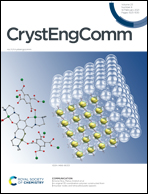Enhanced photoluminescence and photocatalytic performance of a TiO2–ZnWO4 nanocomposite induced by oxygen vacancies
Abstract
Titanium dioxide (TiO2)–zinc tungstate (ZnWO4) nanocomposite powder was prepared by a sol–gel procedure. The X-ray diffraction pattern (XRD) of the nanocomposite indicates that the crystallinity of TiO2 is reduced by coupling with ZnWO4. High resolution microscopic observation of the nanocomposite reveals the intimate contacts formed between the TiO2–ZnWO4 interfaces. The composite’s structure slightly reduces the aggregation of the unmixed TiO2 and ZnWO4, leading to a larger surface area. The photoluminescence (PL) spectrum of the nanocomposite exhibits a prominent broad emission band centered at about 470 nm, compared with that of the pure ZnWO4. Gaussian fitting of the PL peak of the nanocomposite suggests a reduced number of oxygen defects on the ZnWO4 surface. This is further confirmed by X-ray photoelectron spectroscopy (XPS) analysis of the nanocomposite, and the number of oxygen defects on the surface of TiO2 is demonstrated to be increased by coupling with ZnWO4. The photocatalytic activity of the nanocomposite was evaluated by degrading methyl orange under UV light irradiation. The results showed that the photocatalytic performance of TiO2 is much improved through coupling with ZnWO4.

- This article is part of the themed collections: Nanomaterials and Editor’s Collection: Imperfect nanocrystals for Perfect Catalysis


 Please wait while we load your content...
Please wait while we load your content...